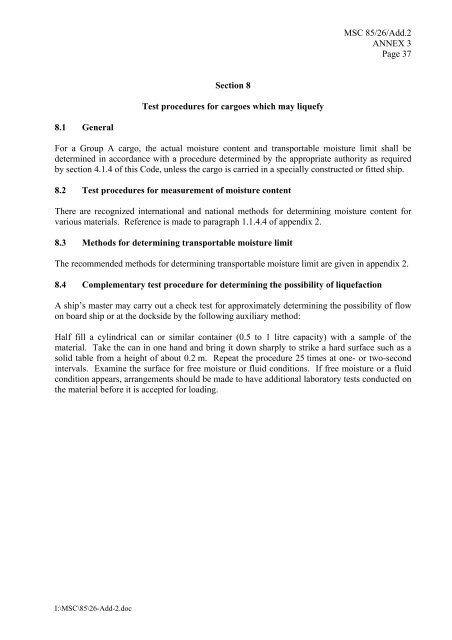MSC 85/26/Add.2 ANNEX 3 RESOLUTION MSC.268(85) - US Coast ...
MSC 85/26/Add.2 ANNEX 3 RESOLUTION MSC.268(85) - US Coast ... MSC 85/26/Add.2 ANNEX 3 RESOLUTION MSC.268(85) - US Coast ...
MSC 85/26/Add.2ANNEX 3Page 36the cargo space. Divisions provided to meet these requirements shall not beconstructed of wood..2 The elements of the ship’s structure bounding such cargo shall be strengthened,as necessary..3 The plan of special arrangements and details of the stability conditions on whichthe design has been based shall have been approved by the Administration.The ship concerned shall carry evidence of approval by the Administration.7.3.2.4 A submission made to an Administration for approval of such a ship shall include:.1 relevant structural drawings, including scaled longitudinal and transverse sections;.2 stability calculations, taking into account loading arrangements and possible cargoshift, showing the distribution of cargo and liquids in tanks, and of cargo whichmay become fluid; and.3 any other information which may assist the Administration in the assessment ofthe submission.I:\MSC\85\26-Add-2.doc
MSC 85/26/Add.2ANNEX 3Page 37Section 8Test procedures for cargoes which may liquefy8.1 GeneralFor a Group A cargo, the actual moisture content and transportable moisture limit shall bedetermined in accordance with a procedure determined by the appropriate authority as requiredby section 4.1.4 of this Code, unless the cargo is carried in a specially constructed or fitted ship.8.2 Test procedures for measurement of moisture contentThere are recognized international and national methods for determining moisture content forvarious materials. Reference is made to paragraph 1.1.4.4 of appendix 2.8.3 Methods for determining transportable moisture limitThe recommended methods for determining transportable moisture limit are given in appendix 2.8.4 Complementary test procedure for determining the possibility of liquefactionA ship’s master may carry out a check test for approximately determining the possibility of flowon board ship or at the dockside by the following auxiliary method:Half fill a cylindrical can or similar container (0.5 to 1 litre capacity) with a sample of thematerial. Take the can in one hand and bring it down sharply to strike a hard surface such as asolid table from a height of about 0.2 m. Repeat the procedure 25 times at one- or two-secondintervals. Examine the surface for free moisture or fluid conditions. If free moisture or a fluidcondition appears, arrangements should be made to have additional laboratory tests conducted onthe material before it is accepted for loading.I:\MSC\85\26-Add-2.doc
- Page 4: MSC 85/26/Add.2ANNEX 3Page 4on the
- Page 8 and 9: MSC 85/26/Add.2ANNEX 3Page 81.5.2 C
- Page 10 and 11: MSC 85/26/Add.2ANNEX 3Page 102 The
- Page 12 and 13: MSC 85/26/Add.2ANNEX 3Page 12Regula
- Page 14 and 15: MSC 85/26/Add.2ANNEX 3Page 14CHAPTE
- Page 16 and 17: MSC 85/26/Add.2ANNEX 3Page 161.7.1
- Page 18 and 19: MSC 85/26/Add.2ANNEX 3Page 181.7.27
- Page 20 and 21: MSC 85/26/Add.2ANNEX 3Page 202.2 Lo
- Page 22 and 23: MSC 85/26/Add.2ANNEX 3Page 223.3 He
- Page 24 and 25: MSC 85/26/Add.2ANNEX 3Page 24Sectio
- Page 26 and 27: MSC 85/26/Add.2ANNEX 3Page 26FORM F
- Page 28 and 29: MSC 85/26/Add.2ANNEX 3Page 28.3 com
- Page 30 and 31: MSC 85/26/Add.2ANNEX 3Page 304.7 Ex
- Page 32 and 33: MSC 85/26/Add.2ANNEX 3Page 325.4.2
- Page 34 and 35: MSC 85/26/Add.2ANNEX 3Page 34Sectio
- Page 38 and 39: MSC 85/26/Add.2ANNEX 3Page 38Sectio
- Page 40 and 41: MSC 85/26/Add.2ANNEX 3Page 409.3.1.
- Page 42 and 43: MSC 85/26/Add.2ANNEX 3Page 429.3.3
- Page 44 and 45: MSC 85/26/Add.2ANNEX 3Page 449.3.4
- Page 46 and 47: MSC 85/26/Add.2ANNEX 3Page 46Sectio
- Page 48 and 49: MSC 85/26/Add.2ANNEX 3Page 4810.8 S
- Page 50 and 51: MSC 85/26/Add.2ANNEX 3Page 50- prep
- Page 52 and 53: MSC 85/26/Add.2ANNEX 3Page 52Sectio
- Page 54 and 55: MSC 85/26/Add.2ANNEX 3Page 5413.2.4
- Page 56 and 57: MSC 85/26/Add.2ANNEX 3Page 56APPEND
- Page 58 and 59: MSC 85/26/Add.2ANNEX 3Page 58ALUMIN
- Page 60 and 61: MSC 85/26/Add.2ANNEX 3Page 60ALUMIN
- Page 62 and 63: MSC 85/26/Add.2ANNEX 3Page 62ALUMIN
- Page 64 and 65: MSC 85/26/Add.2ANNEX 3Page 64ALUMIN
- Page 66 and 67: MSC 85/26/Add.2ANNEX 3Page 66VENTIL
- Page 68 and 69: MSC 85/26/Add.2ANNEX 3Page 68CLEAN-
- Page 70 and 71: MSC 85/26/Add.2ANNEX 3Page 70VENTIL
- Page 72 and 73: MSC 85/26/Add.2ANNEX 3Page 72PRECAU
- Page 74 and 75: MSC 85/26/Add.2ANNEX 3Page 74AMMONI
- Page 76 and 77: MSC 85/26/Add.2ANNEX 3Page 76Approp
- Page 78 and 79: MSC 85/26/Add.2ANNEX 3Page 78STOWAG
- Page 80 and 81: MSC 85/26/Add.2ANNEX 3Page 80EMERGE
- Page 82 and 83: MSC 85/26/Add.2ANNEX 3Page 82HOLD C
- Page 84 and 85: MSC 85/26/Add.2ANNEX 3Page 84AMMONI
<strong>MSC</strong> <strong>85</strong>/<strong>26</strong>/<strong>Add.2</strong><strong>ANNEX</strong> 3Page 37Section 8Test procedures for cargoes which may liquefy8.1 GeneralFor a Group A cargo, the actual moisture content and transportable moisture limit shall bedetermined in accordance with a procedure determined by the appropriate authority as requiredby section 4.1.4 of this Code, unless the cargo is carried in a specially constructed or fitted ship.8.2 Test procedures for measurement of moisture contentThere are recognized international and national methods for determining moisture content forvarious materials. Reference is made to paragraph 1.1.4.4 of appendix 2.8.3 Methods for determining transportable moisture limitThe recommended methods for determining transportable moisture limit are given in appendix 2.8.4 Complementary test procedure for determining the possibility of liquefactionA ship’s master may carry out a check test for approximately determining the possibility of flowon board ship or at the dockside by the following auxiliary method:Half fill a cylindrical can or similar container (0.5 to 1 litre capacity) with a sample of thematerial. Take the can in one hand and bring it down sharply to strike a hard surface such as asolid table from a height of about 0.2 m. Repeat the procedure 25 times at one- or two-secondintervals. Examine the surface for free moisture or fluid conditions. If free moisture or a fluidcondition appears, arrangements should be made to have additional laboratory tests conducted onthe material before it is accepted for loading.I:\<strong>MSC</strong>\<strong>85</strong>\<strong>26</strong>-Add-2.doc



